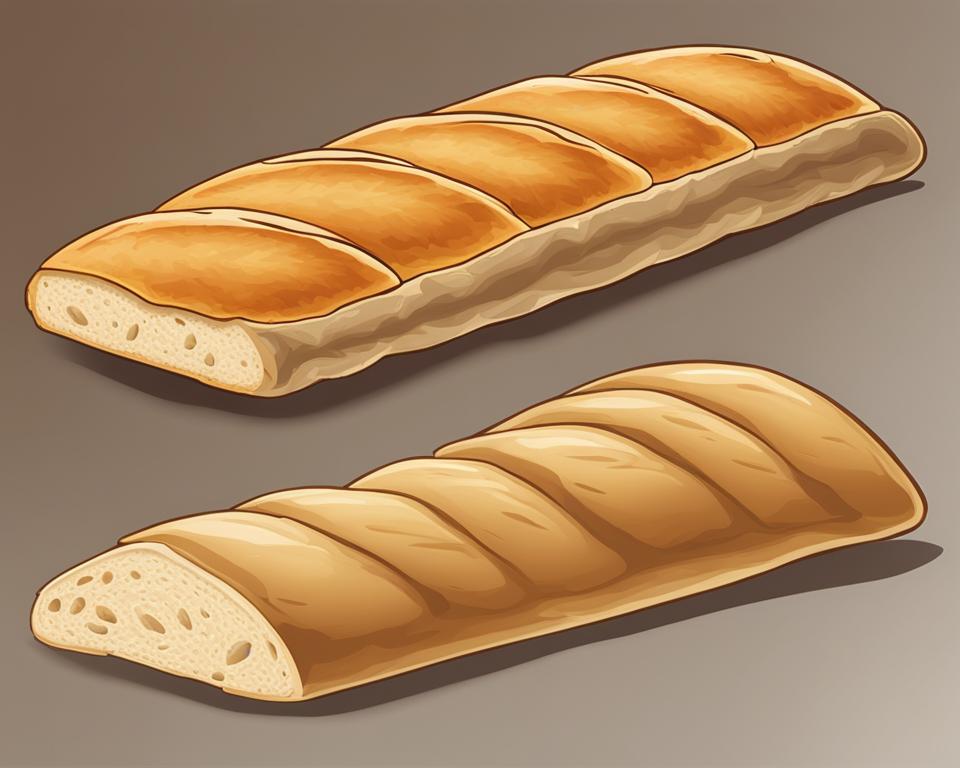In Indian cuisine, there are two classic flatbreads that often confuse people due to their similar appearance – roti and naan. While they may look alike, there are distinct differences in their ingredients, preparation methods, and taste profiles. In this article, we will delve into the unique qualities of each bread, shedding light on what sets roti and naan apart.

Key Takeaways:
- Roti and naan are both popular flatbreads in Indian cuisine.
- Roti is an unleavened bread made from wheat flour and water.
- Naan is a leavened bread made with all-purpose or whole wheat flour, yogurt or buttermilk, and various spices.
- Roti is typically cooked on a tawa (flat skillet), while naan is baked in a tandoor oven.
- Roti is vegan-friendly, while naan contains dairy products and is vegetarian.
Understanding Flatbread Basics
Before diving into the differences between roti and naan, it is important to understand the concept of flatbread. Flatbread is a type of bread made with flour, yogurt, milk, water, and salt. It can be categorized as either unleavened or leavened. Unleavened flatbreads are made without any leavening agents, while leavened flatbreads contain yeast or other leavening agents, resulting in a lighter and puffier texture.
Unleavened flatbreads, such as roti, are popular in many cuisines around the world. They are simple to make, requiring minimal ingredients and preparation time. The dough is typically rolled out and cooked on a hot skillet or tawa, resulting in a thin and crispy bread. Examples of unleavened flatbreads include tortillas, pita bread, and chapati.
On the other hand, leavened flatbreads, like naan, have a more complex preparation process. The dough is typically made with yeast, which helps the bread rise and gives it a softer and chewier texture. Leavened flatbreads are often cooked in a tandoor oven, which imparts a unique charred flavor and a slightly charred texture. Naan, a popular leavened flatbread in Indian cuisine, is known for its fluffy and tender texture.
In summary, flatbread is a versatile type of bread that can be either unleavened or leavened. The choice between the two depends on the desired texture and flavor profile. While unleavened flatbreads like roti offer a thin and crispy experience, leavened flatbreads like naan provide a softer and chewier bite.
Exploring Roti
Roti, also known as chapati, is a popular unleavened flatbread in India. It is made from wheat flour and water, creating a simple yet versatile bread. The dough for roti is typically kneaded using a combination of whole wheat flour (atta) and water, resulting in a smooth and elastic consistency.
One of the distinguishing features of roti is its cooking method. It is traditionally cooked on a flat tawa, which is a cast-iron frying pan. The tawa is heated on a stovetop, and the rolled-out roti is placed on the hot surface. As it cooks, the roti puffs up and develops brown spots, resulting in a soft and slightly charred bread.
Roti can be enjoyed in different variations. It can be served plain or with toppings such as ghee, salt, or oil. Additionally, spices like cumin, turmeric, or ajwain (carom seeds) can be added to the dough for added flavor. Another variation of roti is phulka, where the bread is cooked over an open flame, causing it to puff up even more. This creates a light and airy texture, perfect for tearing and dipping into curries or other dishes.
Variations of Roti
| Roti Variation | Description |
|---|---|
| Plain Roti | Simple roti made with wheat flour and water |
| Roti with Ghee | Roti brushed with ghee for added richness |
| Roti with Spices | Roti flavored with spices like cumin, turmeric, or ajwain |
| Phulka | Puffed roti cooked over an open flame |
“Roti is a versatile flatbread that can be enjoyed in various ways, whether it’s served plain, with toppings, or in its puffed phulka form. Its simplicity and ability to complement a wide range of dishes make it a staple in Indian cuisine.”
Roti is a staple in Indian households and is enjoyed with a variety of dishes such as curries, dal, or vegetables. Its simple yet flavorful taste, combined with its versatility, has made it a popular choice not only in India but also in the international culinary scene.
Understanding Naan
Naan is a beloved leavened flatbread that is a staple in Indian cuisine. It is known for its fluffy texture and delicious flavor. Made with a combination of all-purpose flour and whole wheat flour, naan dough is typically enriched with yogurt or buttermilk, which gives it a unique tanginess. The addition of yeast helps the dough rise, resulting in a bread that is softer and chewier than its unleavened counterpart, roti.
Naan is traditionally cooked in a tandoor oven, which is a cylindrical clay oven. The intense heat cooks the naan quickly, giving it a slightly charred exterior and a tender interior. The tandoor oven also imparts a distinct smoky flavor to the naan, making it even more delicious.
There are various variations of naan that offer a wide array of flavors and fillings. Some popular variations include garlic naan, cheese naan, and peshawari naan. Garlic naan is flavored with garlic and topped with melted butter, while cheese naan is stuffed with a savory cheese filling. Peshawari naan, on the other hand, is sweet and filled with a mixture of dried fruits and nuts. These variations add an extra dimension of taste to the naan and make it a versatile bread that can be enjoyed with a range of dishes.
Naan Varieties:
| Variety | Description |
|---|---|
| Garlic Naan | Flavored with garlic and topped with melted butter |
| Cheese Naan | Stuffed with a savory cheese filling |
| Peshawari Naan | Sweet and filled with a mixture of dried fruits and nuts |
Naan is a versatile and delicious bread that complements a variety of Indian dishes. Its leavened texture, rich flavors, and numerous variations make it a favorite among food enthusiasts. Whether enjoyed plain or filled with enticing ingredients, naan is the perfect accompaniment to curries, kebabs, and other flavorful dishes.
Key Differences Between Roti and Naan
When it comes to Indian flatbreads, roti and naan may look similar, but they have distinct differences in their cooking methods, texture, ingredients, and suitability for different dietary preferences. Let’s explore these differences in detail:
Cooking Methods
The cooking methods for roti and naan vary significantly. Roti is traditionally cooked on a tawa or flat skillet over direct heat, resulting in a thinner and denser texture. On the other hand, naan is cooked in a tandoor oven, which gives it a thicker and chewier texture. The tandoor oven provides a unique smoky flavor to the naan that is not present in roti.
Texture
The texture of roti and naan also differs. Roti has a denser and thinner texture, similar to a whole wheat tortilla. It is relatively plain and less puffy compared to naan. Naan, on the other hand, is thicker and chewier, similar to a soft and fluffy bread. It has a distinct pillowy texture that makes it perfect for tearing apart and dipping into flavorful curries.
Ingredients
The ingredients used in roti and naan are another point of differentiation. Roti is made from whole wheat flour and water, making it a simple and healthy choice. It is typically vegan-friendly as it does not contain any dairy products. On the other hand, naan is made from all-purpose or whole wheat flour, along with yogurt or buttermilk. This combination of ingredients gives naan a richer flavor and softer texture, but it’s important to note that naan is not vegan-friendly due to the dairy content.
Vegan vs. Vegetarian
In terms of dietary preferences, roti is typically suitable for vegans as it does not contain any animal products. On the other hand, naan contains yogurt or buttermilk, making it vegetarian-friendly but not vegan-friendly. If you follow a vegan lifestyle, roti would be the better choice for you.
Serving Style
The serving style of roti and naan also differs. Roti is commonly served plain, acting as a staple accompaniment to curries, dals, and other dishes. It is a versatile bread that can be enjoyed with various Indian meals. Naan, on the other hand, is often served stuffed with fillings like curd, coconut, butter, or cheese. This adds an extra layer of flavor and enhances the overall dining experience. Naan is typically enjoyed with Northern Indian dishes and is a popular choice in Indian restaurants.
In summary, while both roti and naan are delicious Indian flatbreads, they have distinct differences in their cooking methods, texture, ingredients, and suitability for different dietary preferences. Whether you prefer the simplicity of roti or the chewiness of naan, both breads are an integral part of Indian cuisine and offer unique flavors and experiences.
Conclusion
In summary, roti and naan are both delicious Indian flatbreads with their own unique characteristics. The choice between the two ultimately comes down to personal preference and the specific dish you are enjoying.
While roti offers a simpler and thinner texture, naan brings a chewier and thicker experience to the table. Roti is ideal for those seeking a vegan option, as it is typically made with just wheat flour and water. On the other hand, naan is more suitable for vegetarians, as it often contains yogurt or buttermilk as ingredients.
Whether you prefer the no-frills simplicity of roti or the indulgent chewiness of naan, both flatbreads contribute to the rich tapestry of Indian cuisine. No Indian meal is complete without the presence of one or the other. So, next time you’re exploring Indian flavors, don’t forget to savor the distinctive qualities of both roti and naan.
FAQ
What is the difference between roti and naan?
Roti is an unleavened flatbread made from wheat flour and water, while naan is a leavened flatbread made with all-purpose or whole wheat flour, yogurt or buttermilk, and yeast. The cooking methods, texture, and ingredients used in each bread are different.
How is roti cooked?
Roti is typically cooked on a tawa or flat skillet. It can also be cooked over an open flame to create a puffed version called phulka. Additionally, roti can be cooked in a tandoor oven, similar to naan, which gives it a crispy texture.
How is naan cooked?
Naan is cooked in a tandoor oven, which gives it a thicker and chewier texture compared to roti.
Are roti and naan made with the same ingredients?
No, roti is made from wheat flour and water, while naan contains all-purpose or whole wheat flour, along with yogurt or buttermilk.
Is roti suitable for vegans?
Yes, roti is typically vegan-friendly as it does not contain any dairy products.
Can naan be stuffed with fillings?
Yes, naan can be served plain or stuffed with various fillings like curd, coconut, butter, or cheese.

